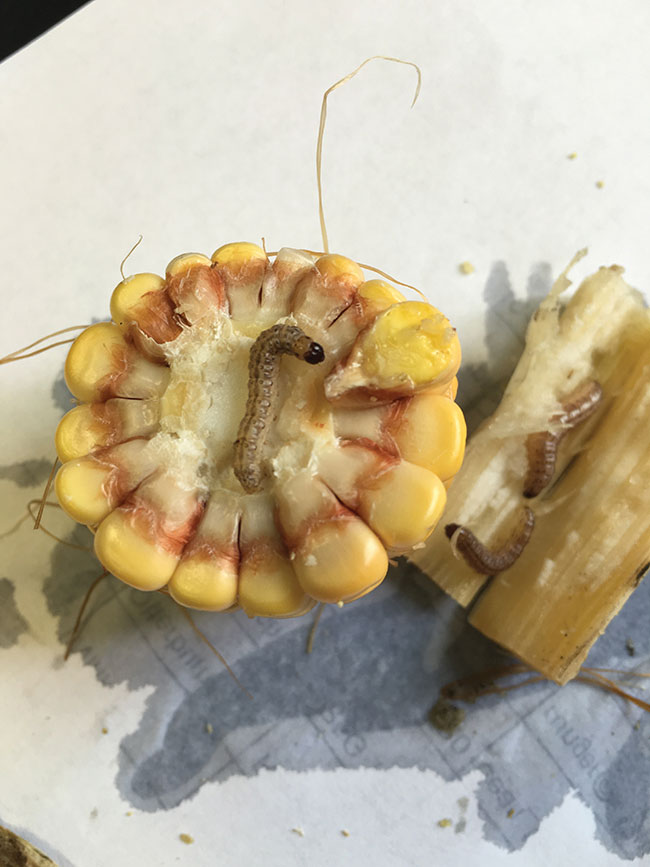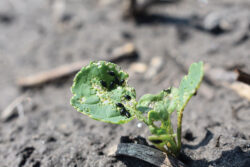
Features
Business
Top business stories of 2023: A controversial ban
By Jack Kazmierski
How a federal insecticide decision could affect livestock producers in Canada.
 European corn borer is among pests that have historically been controlled with lambda-cy products, although alternatives are available.
All images courtesy of Manitoba Crop Alliance
European corn borer is among pests that have historically been controlled with lambda-cy products, although alternatives are available.
All images courtesy of Manitoba Crop Alliance Long used by Canadian farmers to control a variety of insects and commonly sold on the shelves of farm supply stores, lambda-cyhalothrin (known colloqueally as lambda-cy) is a broad-spectrum insecticide that is effective on corn, pulse, small grain and oilseed crops.
However, due to restrictions put in place by Health Canada’s Pest Management Regulatory Agency (PMRA), insecticides that contain lambda-cyhalothrin can no longer be used by Canadian farmers on any feed crops. In other words, as of May 1, 2023 any crops or crop components (fractions, meal, screenings) that have been treated with lambda-cy cannot be fed to any livestock in Canada.
The PMRA’s controversial decision has raised concerns with both growers and livestock producers. Last year, the majority of Canadian grain and livestock producers signed a letter addressed to Canada’s minister of health, Jean-Yves Duclos, urging the government to review this ban.
“Our organizations represent Canada’s grain, feed and livestock value chains, including tens of thousands of farmers, ranchers, industries and employees working to provide safe, abundant, healthy food to Canadians and our customers around the world while contributing billions to Canada’s economy,” the letter read in part. “We are fully aware of the intense global food security challenges we continue to face due to Russia’s invasion of Ukraine, supply chain disruptions, input prices, inflation, and the health, security, and the commercial impacts of climate change. This decision as it currently stands could unnecessarily exacerbate these challenges.”
Focusing on the feed issue, the letter explained how this pesticide ban could lead to limited feed availability, which in turn would impact livestock producers: “The Canadian livestock sector consumes just under 30 million tonnes of feed annually (2020 data). Feed access has been difficult in the last few years due to drought and competition with export markets for domestic grains, all of which have increased feed prices and feed demands. Because of this, Canada’s corn imports from the U.S. have grown substantially to just under 5 million tonnes in 2022. This supply is critical to Canada’s livestock industry. If livestock cannot be fed with Canadian grain treated with lambda-cyhalothrin, and if access to U.S. corn is likewise limited, this has the very real potential to negatively impact the availability of feed for Canadian livestock.”
At this point, however, it’s not clear what kind of impact the ban will have on the availability and price of feed in the future. “It really depends on the year, and how the year’s harvest turns out,” says Janice Tranberg, president and CEO of the National Cattle Feeders Association.
A domestic issue

Lygus bug on sunflower head. Sunflower growers may find themselves with fewer alternatives than other growers.
Technically, lambda-cyhalothrin can be used on crops intended for human consumption, “but since any crop entering the grain handling system is eligible for livestock feed, this poses a risk of becoming an off-label use,” explained Ian Epp, agronomy specialist with the Canola Council of Canada during his presentation at the “Keep it Clean Product Advisory Webinar,” which took place in April, 2023.
“However, if the grain is being exported, that’s fine,” added Epp. “And if it’s being exported for feed, that’s fine too. Or if it’s going to be used for food, that’s acceptable.”
Greg Bartley, director of crop protection and crop quality for Pulse Canada, spoke at the same webinar and added: “Lambda is not an issue with export markets. This is a domestic issue. So if you’re exporting, we haven’t seen other markets take a restrictive approach to lambda. This is really a domestic feed issue.”
Differing views
Both the U.S. and Canada looked at the lambda-cyhalothrin question, but only Canada decided that the pesticide needed to be banned. When asked why, Mark Johnson, spokesperson for Health Canada and the Public Health Agency of Canada said, “Canada’s decision on certain pesticides may be different than those of other international pesticide regulators due to differences in policies and legislation, differences in how the pesticides are used [crops, rates] and differences in the data available at the time of review.”
In a written statement, Johnson also explained why lambda-cy is only banned for use on crops meant for feed, and not for human consumption: “The risk of concern is not for the health of the animals, but for the vulnerable human populations who consume foods of animal origin, such as milk, cheese and meat. The grain fed to livestock may result in concentrations of lambda-cyhalothrin being found in foods of animal origin.”
Dissenting voices
PMRA’s ban has not been welcomed warmly by many industry stakeholders.
The Government of Saskatchwan issued a statement stating: “While we support the PMRA decision to maintain registration of products with this active ingredient for food crop use, the decision included cancelling registration on crops used for feed… It is also unclear how this provision would apply to imported grain entering Canada for use as feed.” The Government of Saskatchewan, among others, has requested that Health Canada rethink its decision.
Finding alternatives
While Health Canada reviews its decision, farmers across Canada have been forced to find alternatives to lambda-cyhalothrin.

Flea beetles on a seeding canola plant. The Canola Council of Canada have listed alternatives to Lamba-Cy for such control.
Fortunately, according to experts, there are a number of insecticides on the market that can be used as substitutes. “For pretty much all the pests that lambda is registered, we have alternatives,” says Epp. “There are some nuances in how we apply them, and in general they work equally well. You just have to be careful how you apply them.”
Morgan Cott, agronomy extension specialist – special crops with the Manitoba Crop Alliance agrees.
“There is a long list of insecticides and potential insecticides to use for each crop and insect,” she explains. “It’s just that these lambda products were very trusted and people knew how they work because they’ve been using them for many years. So taking something out of the market that’s been there for so long, and is well understood, is making lives a little bit more difficult.” Cott explains that although most crops can be protected by pesticides without lambda-cy, a few growers might be left without an alternative.
“Some crops, and some insects in those crops, will not be controlled at all,” she explains. “I deal with specialty crops, including corn, sunflower and flax for our commodity association, and I can tell you that sunflowers now have no insecticide to control lygus bugs.”
Growers associations across Canada have published guides that list alternatives to lambda-cyhalothrin, detailing which crops will benefit from which lambda-cyhalothrin alternatives, based on the particular pest that needs to be controlled. Moreover, since pesticide manufacturers have known for years that the lambda-cyhalothrin restrictions would come into effect in 2023, Cott says that there should be no shortage of product on the shelves.
Examples provided by the Manitoba Crop Alliance include: chlorantraniliprole, spinetoram or malathion for armyworm in barley, wheat and oats; chlorantraniliprole, deltamethrin or permethrin for cutworm in canola; chlorantraniliprole, deltamethrin or malathion for diamondback moth in canola, and more. A full list is available online at: https://mbcropalliance.ca/assets/uploads/images/MCA_Lambda-Cy-and-Alternative-Chemistries-factsheet-v3.pdf, and growers are reminded to always refer to product labels for efficacy and application details. Canola producers can also refer to the Canola Council of Canada’s FAQ page, which includes links to alternatives both for specific pests and for the three Prairie provinces.
She adds that this ruling by the PMRA is more of an annoyance than a problem, simply because most growers (except sunflower crops) will be able to find a pesticide they can use in place of lambda-cy. “Aside from sunflowers, our crops generally have a pretty good list of options,” she adds.
Working with options
Many growers must now learn how to use a range of options available on the market.
In a recent letter, addressed to Peter Brander, executive director of the PMRA, a group comprised of the National Cattle Feeders Association, the Canadian Pork Council, the Canadian Meat Council and the Canadian Cattle Association joined forces to send a strong message of concern: “Livestock producers are often challenged to secure feed sources for their animals due to events such as drought, flooding and supply chain disruptions… Regulations such as the one in question present a very significant challenge that can negatively impact the ability to secure feed sources for Canadian livestock.
While the lambda-cyhalothrin decision has created challenges for Canada’s grain and livestock producers, it’s unclear at this point just how damaging it will turn out to be for all stakeholders. While alternatives are available, some question how effective they will be, and whether the switch will create shortages of feed in the months and years to come, spiking prices for all. At this point, only time will tell.
Print this page